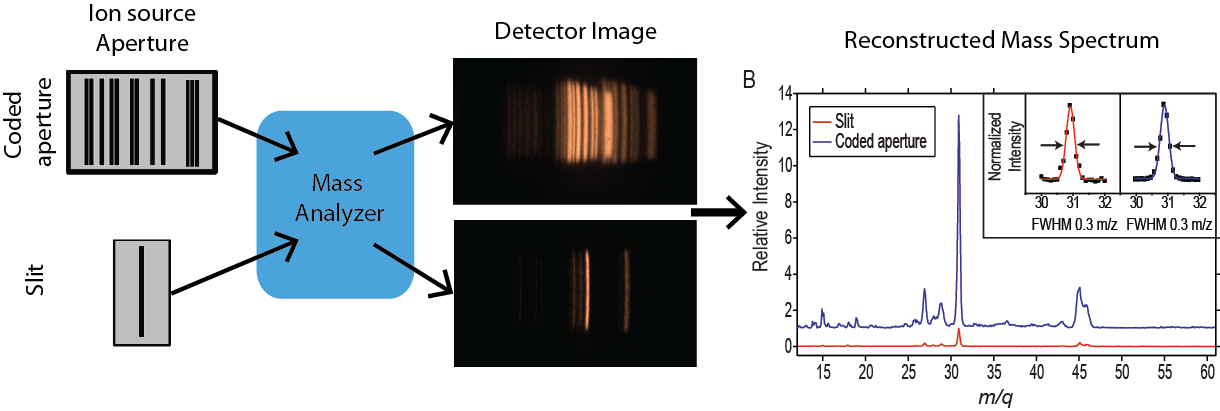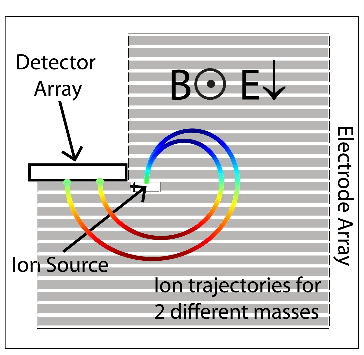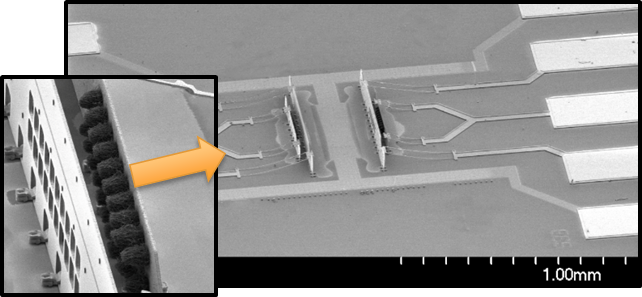The size and cost of traditional mass spectrometers have typically limited their application to laboratory settings. Magnetic sector mass analyzers in particular, while noted for their high mass accuracy, suffer from large size, weight, and power requirements. Miniaturization of mass spectrometers will enable their use in a wide variety of field applications and low-analyte-volume uses. However, miniaturization often forces the instrument designer to confront a tradeoff between instrument throughput (and associated signal-to-background-ratio (SBR)) and spectral resolution.
In collaboration with the Brady and Gehm groups, the Nanomaterials and Thin-films Laboratory has demonstrated that the use of coded apertures in magnetic sector mass spectrometers can break the throughput vs. resolution tradeoff. Using 1D and 2D apertures, we have shown up to 10x throughput increase without loss of resolution.[1, 2]. Recently, we published an article demonstrating the compatibility of coded apertures in the popular Mattauch-Herzog mass analyzer, which was featured on the April 2016 cover.[3]
Our current work in this area is part of the ARPA-E MONITOR program. The MONITOR (Methane Observation Networks with Innovative Technology to Obtain Reduction) program is focused on reducing methane emissions associated with energy production to build a more sustainable energy future. The three-year, $3 million project will design, build and commercialize a coded aperture miniature mass spectrometer for environmental sensing (CAMMS-ES) that can serve as an efficient and sensitive natural gas emissions detector. Our partners and collaborators on this project include RTI International and the University of Arizona.
(CAMMS-ES) uses disruptive technologies including:
- Aperture coding to increase throughput without sacrificing resolution, thus enabling miniaturization.
- A cycloidal double-focusing mass analyzer geometry.
- Microfabrication of the detector and ion source with field emission cathode.
- State-of-the-art emission localization algorithms.
The instrument will incorporate sampling techniques to allow for continuous concentration measurements with discrimination, speciation, and localization of natural gas hydrocarbons including alkanes such as methane, ethane, butane and propane as well as volatile organic compounds such as benzene, ethylbenzene, and toluene.

1. Aperture Coding: Increased throughput, no loss in resolution

2. Cycloidal mass analyzer

3. Microfabricated CNT field emission electron ionization source.

4. Emission locaization algorithms
Recent publications:
[1] Evan X Chen, Zachary E Russell, Jason J Amsden, Scott D Wolter, Ryan M Danell, Charles B Parker, Brian R Stoner, Michael E Gehm, Jeffrey T Glass, David J Brady,Order of Magnitude Signal Gain in Magnetic Sector Mass Spectrometry Via Aperture Coding, Journal of The American Society for Mass Spectrometry 2015, 26, 1633.
[2] Zachary E Russell, Evan X Chen, Jason J Amsden, Scott D Wolter, Ryan M Danell, Charles B Parker, Brian R Stoner, Michael E Gehm, David J Brady, Jeffrey T Glass,Two-Dimensional Aperture Coding for Magnetic Sector Mass Spectrometry, Journal of The American Society for Mass Spectrometry 2015, 26, 248.
[3] Zachary E. Russell, Shane T. DiDona, Jason J. Amsden, Charles B. Parker, Gottfried Kibelka, Michael E. Gehm, Jeffrey T. Glass,Compatibility of Spatially Coded Apertures with a Miniature Mattauch-Herzog Mass Spectrograph, Journal of The American Society for Mass Spectrometry 2016, 27, 578.
The information, data, or work presented herein was funded in part by the Advanced Research Projects Agency-Energy (ARPA-E), U.S. Department of Energy, under Award Number DE-AR0000546. The views and opinions of authors expressed herein do not necessarily state or reflect those of the United States Government or any agency thereof.
